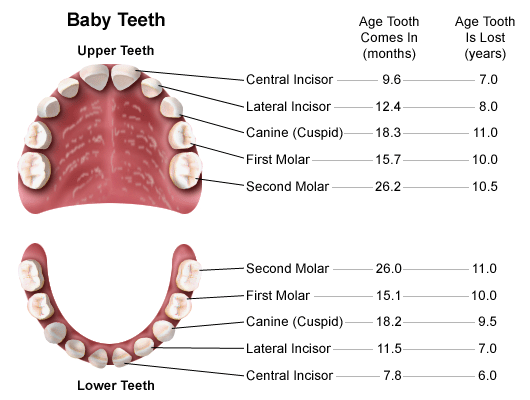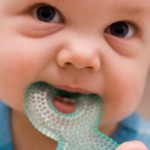Baby Teething Age Chart
When do baby teeth ?
All of us have teeth, but the age at which we get first tooth or milk tooth, is not the same for all. Some children get their first tooth by the age of 4 months while others may not get one till one year. Both types of children are normal, provided they are healthy and active otherwise. Napoleon and Julius Ceaser were known to be born with a tooth. You cannot judge a child as being extra bright for teething early, nor can you define one as backward dust because he has teethed late. An average child gets the first tooth around the seventh month. However, the child very often tends to start drooling, biting and getting irritable, months before this.
Baby Teething Order Chart with Age

Just look at the baby teething chart shown above. The first teeth to appear are the lower two front teeth (central incisors) by approximately 7 months, the upper two central incisors by about the 9th month and the upper two lateral incisors erupt by about 1 year. So by one year, the child has 6 teeth. This is followed by a pause. Then the lower 2 lateral incisors come by 15 months. This is followed by the 4 first molars by the end of one-and-half-years. Morals appear by the end of 2 years. Canines appear by two-and-a-half years.
Baby Teething Symptoms & Problems
The infant sees and explores the world with his mouth. The eruption of teeth is a new experience for him. Since the infant has a tendency to put all objects he sees into the mouth, this can result in inflammation of the gums, since the gums may get cut between the teeth and other hard objects. This is the reason behind babies are fuzzy, feel discomfort and have some problems during teething.
This is the reason behind babies are fuzzy, feel discomfort and have some problems during teething.
- Children tend to put things in their mouth, makes them feel good. As a result of this they often get infections of the digestive tract which results loss of appetite and loose motions. This is the most common reason why loose motions are always associated by our mothers and grandmothers with teething.
- Baby teething can lead to intermittent localized discomfort in the area of an erupting tooth and subsequent irritability. Low grade fevers may be associated with teething, but this has not been established. Many children go through teething without any apparent problem, whereas others have significant discomfort.
- Some mothers get very anxious over the child’s putting things in her own mouth. No amount of stopping can help. You can give your child clean plastic, silicon or rubber teethers. Quality of the baby teethers must be excellent to avoid any problem to your little one. You can also give carrots for your child to chew upon. However, take care to see that the child does not bite off a part of the carrot or rubber teether and get choked by it.
- It must be kept in mind, for infant the mouth is window to the world. Infants put anything that they fancy into their mouths. This is because one of the first experiences of the infant is sucking.
Child’s permanent teething order
These appear by 6 years. The baby loses the milk teeth in the same order as they have appeared. The permanent teeth push upwards from underneath and thus destroys the roots of the milk teeth. These milk teeth then loosen and fall off, giving place to the permanent teeth. Substitution of milk teeth is complete around 12-14 year. For reference, look at the infant teething chart given above. The wisdom teeth come later and sometimes never. These teeth have jagged edges when they appear which later wear down to a smooth finish.